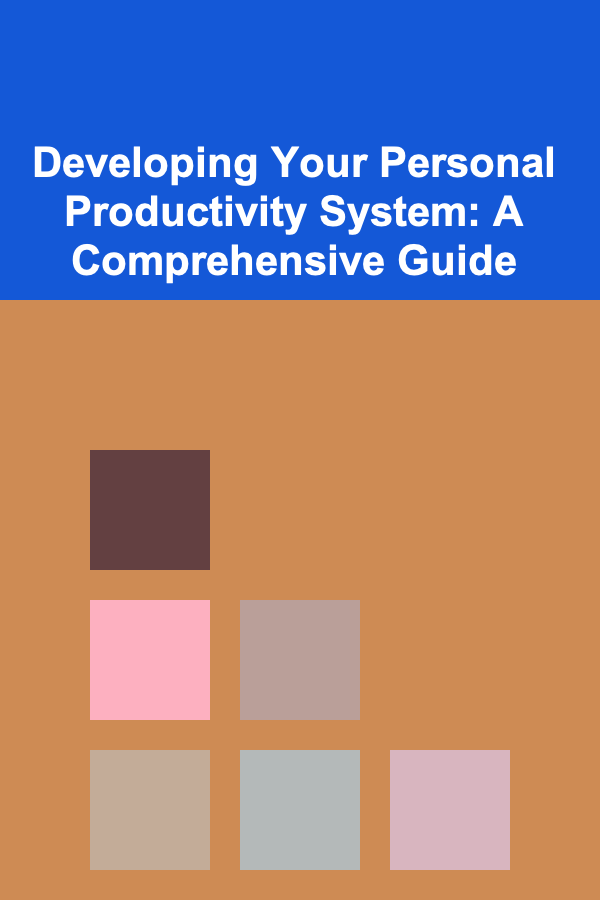
Developing Your Personal Productivity System: A Comprehensive Guide
ebook include PDF & Audio bundle (Micro Guide)
$12.99$10.99
Limited Time Offer! Order within the next:

In today's fast-paced world, the ability to manage your time, tasks, and energy effectively is crucial for achieving your goals and maintaining a healthy work-life balance. A personal productivity system is not just about getting more done; it's about getting the right things done, consistently, and with minimal stress. This guide provides a deep dive into the principles and practices of building a personalized productivity system that works for you.
Understanding Productivity: Beyond the Buzzwords
Before diving into specific techniques, it's essential to understand what productivity truly means. It's not simply about being busy. True productivity involves:
- Effectiveness: Doing the right things that contribute to your goals. Prioritization is key here.
- Efficiency: Doing things in the most time and resource-efficient manner possible. Streamlining processes and eliminating waste are crucial.
- Consistency: Maintaining a sustainable pace and adhering to your system over the long term. Avoiding burnout is paramount.
- Focus: Minimizing distractions and staying present in the task at hand.
- Well-being: Recognizing that productivity is intertwined with physical and mental health. Rest, exercise, and relaxation are integral parts of a sustainable system.
Many people fall into the trap of chasing trendy productivity hacks without understanding the underlying principles. These hacks often provide a temporary boost but ultimately fail because they don't address the individual's specific needs and circumstances. A truly effective system is one that is tailored to your work style, values, and goals.
Phase 1: Self-Assessment and Goal Definition
The foundation of any successful productivity system is a thorough understanding of yourself and your objectives. This phase involves introspection and honest assessment.
1. Identifying Your Values and Goals: The North Star
What truly matters to you? What do you want to achieve in the long term? Your personal values and goals serve as the "North Star" guiding your daily actions. Without clarity in this area, you risk spending your time on activities that don't align with your core aspirations.
Consider these questions:
- What are your top 3-5 values? (e.g., Creativity, Family, Security, Learning, Health)
- What are your long-term goals in various areas of your life (career, relationships, health, personal development)? Be specific.
- What does success look like to you in each of these areas?
Write down your answers. This written articulation will provide a solid foundation for all subsequent steps.
2. Analyzing Your Current Workflow and Habits
Take a critical look at your current work habits. Where are you excelling? Where are you struggling? This is an exercise in self-awareness, not self-criticism. The goal is to identify areas for improvement.
Consider these aspects:
- Time Management: How do you currently allocate your time? Use a time tracking app (Toggl Track, RescueTime) for a week to get an objective view.
- Task Management: How do you manage your tasks? Do you use a to-do list, calendar, or project management software? What works and what doesn't?
- Distractions: What are your biggest distractions? (e.g., social media, email, notifications, chatty colleagues)
- Energy Levels: When are you most productive during the day? When do you experience energy dips?
- Procrastination: What tasks do you tend to procrastinate on? Why? What are the underlying fears or anxieties?
- Tools & Technology: What tools are you currently using? Are they helping or hindering your productivity? Are they integrated effectively?
Be honest with yourself. The more accurate your assessment, the more effective your system will be.
3. Identifying Your Productivity Style
Everyone has a different way of working. Some thrive in structured environments, while others prefer more flexibility. Some are morning people, while others are night owls. Understanding your personal productivity style is crucial for tailoring your system.
Consider these questions:
- Do you prefer to work in large blocks of uninterrupted time or in smaller bursts?
- Are you a visual, auditory, or kinesthetic learner? How can you incorporate this into your workflow?
- Do you prefer to work alone or in collaboration with others?
- Do you thrive under pressure or do you prefer a more relaxed pace?
- Are you a perfectionist or do you prioritize getting things done over achieving perfection?
There are also various personality frameworks (e.g., Myers-Briggs, Enneagram) that can provide insights into your work style and preferences. However, avoid relying solely on these frameworks. Use them as a starting point for self-exploration, but ultimately trust your own experience and intuition.
Phase 2: Building Your Productivity Toolkit
Once you have a clear understanding of your values, goals, and work style, you can start building your productivity toolkit. This involves choosing the right tools and techniques to support your system.
1. Task Management Systems: Getting Everything Out of Your Head
A robust task management system is the cornerstone of any effective productivity system. Its primary purpose is to capture all your tasks, projects, and ideas in a central location, freeing up your mental space and preventing things from falling through the cracks.
There are many task management tools available, each with its own strengths and weaknesses. Some popular options include:
- Digital Tools:
- Todoist: A user-friendly and versatile task manager with cross-platform support and powerful features like recurring tasks and project management.
- Things 3 (macOS/iOS only): A beautifully designed and intuitive task manager known for its focus on simplicity and elegance.
- Asana/Trello/Monday.com: Project management tools suitable for managing complex projects and collaborating with teams. However, they can also be used for personal task management.
- Microsoft To Do: A simple and free task manager integrated with the Microsoft ecosystem.
- Google Tasks: Another free and simple option integrated with Google Workspace.
- Notion: A powerful and flexible workspace that can be used for task management, note-taking, project management, and more.
- Analog Tools:
- Bullet Journal: A customizable and flexible system that combines note-taking, task management, and journaling.
- Paper Planner: A traditional planner that allows you to schedule appointments, track tasks, and make notes.
- Index Cards: A simple and versatile tool for capturing ideas and breaking down tasks.
The best tool is the one that you will actually use consistently. Consider your preferences, budget, and the complexity of your tasks when making your choice. Don't be afraid to experiment with different tools until you find one that fits your needs.
Regardless of the tool you choose, your task management system should allow you to:
- Capture all your tasks and ideas: Don't rely on your memory. Write everything down.
- Organize your tasks into projects and contexts: This will help you prioritize and focus on the most important tasks.
- Set deadlines and reminders: This will help you stay on track and avoid missing deadlines.
- Review your tasks regularly: This will ensure that your system remains up-to-date and relevant.
- Break down large tasks into smaller, more manageable steps: This will make them less daunting and easier to complete.
2. Time Management Techniques: Mastering Your Time
Effective time management is essential for maximizing your productivity. There are many time management techniques available, but the key is to find ones that resonate with you and that you can implement consistently.
Here are some popular techniques:
- The Pomodoro Technique: Work in focused 25-minute intervals, followed by a 5-minute break. After four Pomodoros, take a longer break (20-30 minutes). This technique helps to maintain focus and prevent burnout.
- Time Blocking: Schedule specific blocks of time for specific tasks in your calendar. This helps you to prioritize your time and allocate sufficient time for important activities.
- The Eisenhower Matrix (Urgent/Important Matrix): Categorize your tasks based on their urgency and importance. Focus on tasks that are important but not urgent, delegate or eliminate tasks that are urgent but not important, and schedule time for tasks that are both urgent and important.
- The Two-Minute Rule: If a task takes less than two minutes to complete, do it immediately. This prevents small tasks from accumulating and becoming overwhelming.
- Eat the Frog: Tackle your most challenging or unpleasant task first thing in the morning. This allows you to get it out of the way and start the day with a sense of accomplishment.
Experiment with different techniques and see what works best for you. Remember that the goal is not to rigidly adhere to a particular method, but to develop a flexible and adaptable approach to time management.
3. Note-Taking Systems: Capturing Ideas and Information
A well-organized note-taking system is essential for capturing ideas, processing information, and building a knowledge base. This can be particularly important for creative work, research, and learning.
Consider these note-taking strategies and tools:
- Linear Notes: Traditional notes taken in a sequential fashion, often used for lectures and meetings.
- Mind Maps: Visual diagrams that connect ideas and concepts in a non-linear fashion. Useful for brainstorming and organizing complex information.
- Cornell Notes: A structured note-taking system that involves dividing your page into three sections: notes, cues, and summary.
- Zettelkasten: A knowledge management system that involves creating interconnected notes, or "zettels," that can be linked together to form a network of knowledge. (Tools: Obsidian, Roam Research, Logseq)
- Digital Note-Taking Apps: Evernote, OneNote, Apple Notes, Google Keep. Choose one that integrates well with your workflow.
The key is to develop a system that allows you to easily retrieve and connect information. Experiment with different methods and tools until you find one that suits your needs.
4. Communication Management: Minimizing Distractions and Maximizing Focus
Constant interruptions from email, social media, and messaging apps can significantly impact your productivity. It's essential to develop strategies for managing your communication effectively.
Here are some tips:
- Batch Your Communication: Instead of checking email or social media constantly, schedule specific times during the day to respond to messages.
- Turn Off Notifications: Disable notifications for apps that are not essential. This will help you to stay focused on your work.
- Use a Communication Filter: Create rules or filters to automatically sort and prioritize your emails.
- Set Boundaries: Let colleagues and friends know when you are unavailable for communication.
- Use "Do Not Disturb" Mode: Utilize the "Do Not Disturb" mode on your phone and computer to block out distractions.
Be proactive in managing your communication. Don't let it control you. Take charge and create a system that supports your focus and productivity.
Phase 3: Implementing and Refining Your System
Building a productivity system is an ongoing process. It's not a one-time event. You need to continuously implement, evaluate, and refine your system to ensure that it continues to meet your needs.
1. Start Small and Experiment: The Agile Approach
Don't try to implement all the changes at once. Start with a few small, manageable changes and gradually add more as you become comfortable with the new system. This agile approach allows you to experiment and adjust your system based on your experience.
For example, you might start by implementing the Pomodoro Technique for a few hours each day. Once you've mastered that, you can add time blocking or another time management technique.
2. Regularly Review and Reflect: The Feedback Loop
Schedule regular reviews of your productivity system. This is an opportunity to assess what's working, what's not working, and what needs to be adjusted. Consider these questions:
- Are you achieving your goals?
- Are you managing your time effectively?
- Are you experiencing less stress and more focus?
- Are there any areas of your system that need improvement?
- Are you using the right tools and techniques?
Use this feedback to refine your system and make it even more effective. Your productivity system should be a living document, constantly evolving to meet your changing needs.
3. Embrace Flexibility and Adaptability: The Key to Long-Term Success
Life is unpredictable. Unexpected events and changes in circumstances can disrupt your carefully laid plans. It's important to be flexible and adaptable in your approach to productivity.
Don't be afraid to deviate from your system when necessary. The goal is not to rigidly adhere to a set of rules, but to use the system as a guide to help you achieve your goals. If something is not working, be willing to change it.
4. Prioritize Self-Care: The Foundation of Sustainable Productivity
Productivity is not just about working harder. It's about working smarter and taking care of yourself. Prioritize self-care activities that help you to recharge and maintain your well-being.
Consider these activities:
- Sleep: Aim for 7-8 hours of sleep each night.
- Exercise: Engage in regular physical activity.
- Healthy Eating: Eat a balanced diet.
- Mindfulness and Meditation: Practice mindfulness and meditation to reduce stress and improve focus.
- Hobbies and Interests: Dedicate time to activities that you enjoy.
- Social Connection: Spend time with loved ones.
- Breaks: Take regular breaks throughout the day to avoid burnout.
Remember that your physical and mental health are essential for sustained productivity. Invest in your well-being, and you will reap the rewards in all areas of your life.
Conclusion: The Journey to Personal Productivity Mastery
Developing a personal productivity system is a journey, not a destination. It requires ongoing effort, experimentation, and self-reflection. By understanding your values, goals, and work style, and by choosing the right tools and techniques, you can create a system that empowers you to achieve your full potential and live a more fulfilling life.
Don't be discouraged if you don't see results immediately. It takes time and practice to develop new habits. Be patient with yourself, celebrate your successes, and learn from your mistakes. With persistence and dedication, you can master the art of personal productivity and create a life that is both productive and meaningful.
Ultimately, your personal productivity system is a reflection of you. It should be tailored to your unique needs and aspirations. Embrace the process of continuous improvement, and you will be well on your way to achieving your goals and living a more productive and fulfilling life.

How to Decorate Your Rental Property on a Budget
Read More
How to Make Family Time More Meaningful with Simple Activities
Read More
How to Maximize Bedroom Storage Without Sacrificing Style
Read More
How to Organize Your Garden for Seasonal Blooms
Read More
How to Save Money on Home Heating and Cooling with Smart Budgeting
Read More
How To Use Canva for Easy POD Design Creation
Read MoreOther Products

How to Decorate Your Rental Property on a Budget
Read More
How to Make Family Time More Meaningful with Simple Activities
Read More
How to Maximize Bedroom Storage Without Sacrificing Style
Read More
How to Organize Your Garden for Seasonal Blooms
Read More
How to Save Money on Home Heating and Cooling with Smart Budgeting
Read More